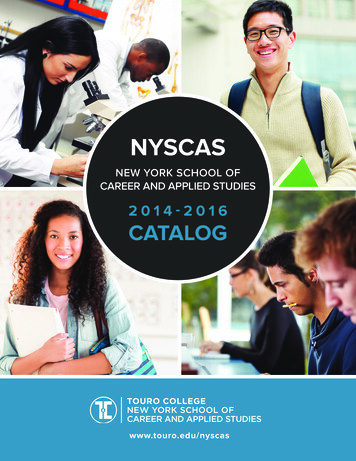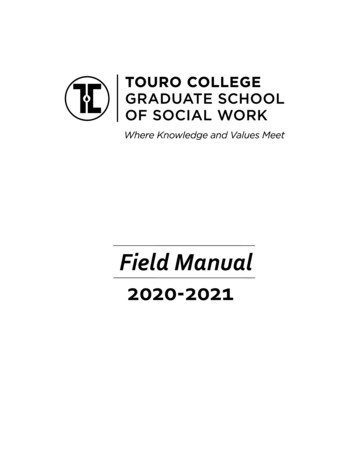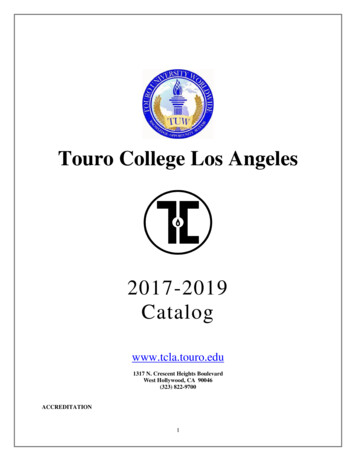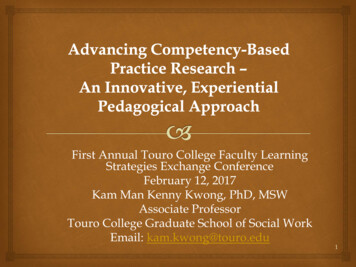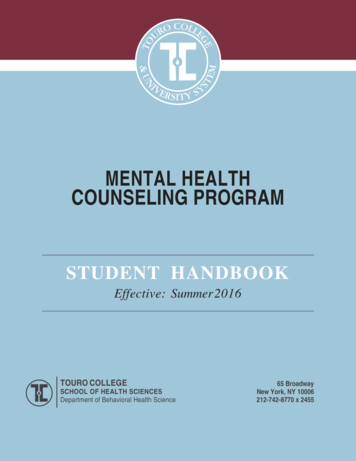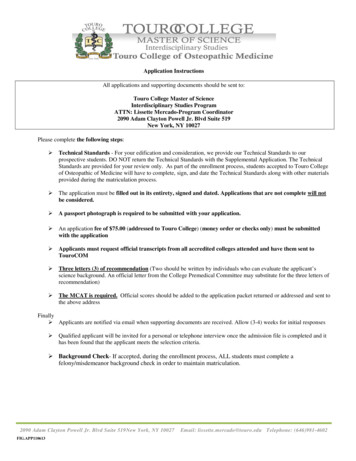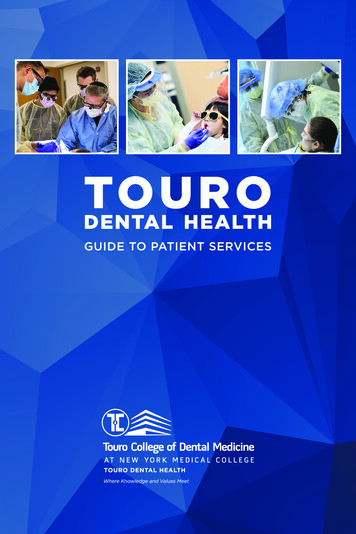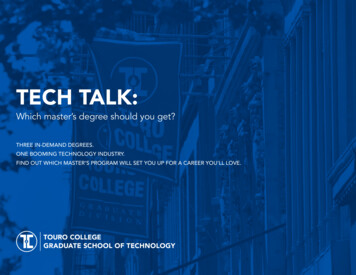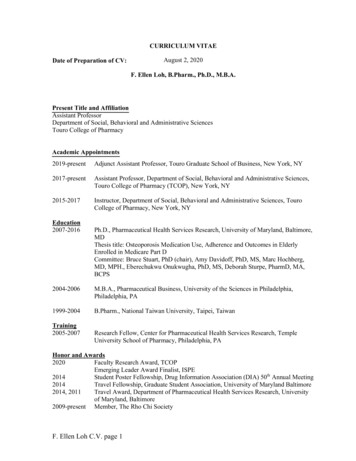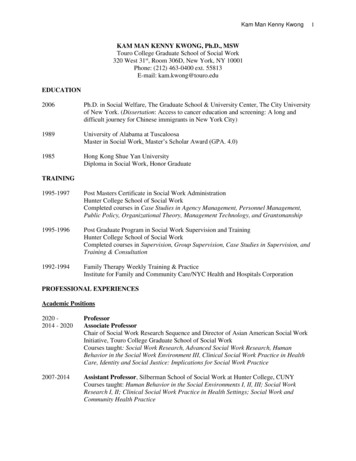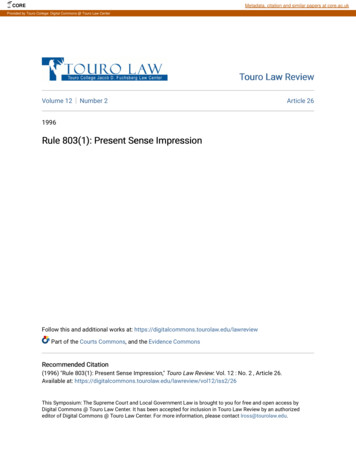
Transcription
COREMetadata, citation and similar papers at core.ac.ukProvided by Touro College: Digital Commons @ Touro Law CenterTouro Law ReviewVolume 12Number 2Article 261996Rule 803(1): Present Sense ImpressionFollow this and additional works at: https://digitalcommons.tourolaw.edu/lawreviewPart of the Courts Commons, and the Evidence CommonsRecommended Citation(1996) "Rule 803(1): Present Sense Impression," Touro Law Review: Vol. 12 : No. 2 , Article 26.Available at: 2/iss2/26This Symposium: The Supreme Court and Local Government Law is brought to you for free and open access byDigital Commons @ Touro Law Center. It has been accepted for inclusion in Touro Law Review by an authorizededitor of Digital Commons @ Touro Law Center. For more information, please contact lross@tourolaw.edu.
et al.: FRE and NY Evidence ComparisonRULE 803(1): PRESENT SENSE IMPRESSIONFederal Rule of Evidence 803(1) states:The following are not excluded by the hearsay rule, eventhough the declarant is available as a witness:(1) Present sense impression. A statement describing orexplaining an event or condition made while the declarant wasperceiving the event or condition, or immediately thereafter. 1The law of evidence was slow to recognize an exception to thehearsay rule for present sense impressions. 2 The primary reasonfor this hesitation was the belief that statements made about anevent without an accompanying nervous stimuli might beunreliable. 3 The courts felt that, unlike the exception for excitedutterances, 4 present sense impressions lacked a sufficient indiciaof reliability because they were sought to be admitted basedsolely upon the contemporaneous making of the statement. 5In 1942, a state appellate court recognized the inherentreliability of such statements in Houston Oxygen Co. v. Davis.61. FED. R. EvD. 803(1).2. See JACK B. WEINSTEIN & MARGARET A. BERGER, WEINSTEIN'SEVIDENCE 803(1)[01], at 87-88 (Joseph M. McLaughlin ed., 1995) (statingthat the reluctance to admit these statements was largely based upon the factthat many courts relied upon the criticized phrase of "res gestae"); see alsoJoHN HENRY WIGMORE, WIGMORE ON EVIDENCE §1757, at 238 (James H.Chadboum ed., 1974) (maintaining that a startling event is a necessaryprerequisite to admitting spontaneous exclamations to ensure theirtrustworthiness).3. The courts believed that out of court statements made under theinfluence of an exciting event were reliable because they were less likely to bethe product of fabrication. See FED. R. EvID. 803 advisory committee's note.4. FED. R. EvD. 803(2). The hearsay exception for excited utterances isdefined as: "[a] statement relating to a startling event or condition made whilethe declarant was under the stress of excitement caused by the event orcondition." Id.5. See WEINSTEIN & BERGER, supra note 2, § 803(1)[01], at 87-88.6. 161 S.W.2d 474 (Com. App. Tx. 1942). In this case, the plaintiffssought recovery for injuries sustained as a result of a collision between theplaintiff's automobile and the defendant's truck. Id. at 475. Defendant soughtto admit statements made by a motorist who, after witnessing the plaintiff's car"zig zagging" and traveling at an excessive speed, stated that the driver "must555Published by Digital Commons @ Touro Law Center, 20201
Touro Law Review, Vol. 12 [2020], No. 2, Art. 26TO URO LAW REVIEW[Vol 12In Houston, the court found that the statement's reliability wasensured by factors other than the excitement of the event,including the close proximity between the event and thestatement, and the fact that the statements were made to a thirdperson who was at the scene and who was subject to crossexamination. 7 The Commission of Appeals of Texas stated thatthe time factor offered two safeguards: (1) the avoidance oferrors because of the declarant's clear memory, and (2) the lack8of time to make a calculated misstatement.After the Houston case, courts gradually began to accept thisexception to the hearsay rule; however, "[tihe principal impetusfor recognition of the hearsay exception for unexcited statementsof present sense impressions came through the rulemakingprocess." 9 The rule was recognized by its inclusion in the Modelhave been drunk" and could have caused the accident. Id. at 476. TheCommission of Appeals of Texas reversed the trial court's decision and heldthat the statement should be admitted because of its exceptional reliabilityunder the hearsay exception for spontaneous declarations. Id. at 477. The courtfurther stated that the decision to admit the evidence was not within thediscretion of the trial court when the circumstances under which the statementwas made fell within an established rule of evidence. Id.7. Id. at 476-77.8. Id. at 477. Though there were virtually no federal cases whichrecognized the present sense impression exception before the promulgation ofthe Federal Rules of Evidence, some cases seemed to support this exception.Emens v. Lehigh Valley R. Co., 223 F. 810 (N.D.N.Y. 1915), cert. denied,242 U.S. 627 (1916). See WEINSTEIN & BERGER, supra note 2, 803(1)[01] at89. In Einens, a car and a train collided. 223 F. at 812. There was inconsistenttestimony as to whether or not the train had blown its whistle before it crossedthe highway and caused the accident. Id. at 815-19. A witness who was inclose proximity to the collision was allowed to testify that his wife said, "[d]oyou suppose the people in that automobile see the train?" and "[w]hy don't thetrain whistle?" Id. at 825. Though the evidence was admitted only to showwhether the husband's attention was directed to the sounding or the nonsounding of the bell, the court stated that the wife's testimony "might becompetent" on the issue of whether the train actually did signal. Id. at 826.The court further stated that since the wife's statement "was entirelydisinterested, and it was spontaneous (drawn out by the conditions existing),and there was no premeditation. . . it was relevant". Id.9. MCCORMICK ON EVIDENCE § 271, at 475 (John William Strong ed.,4th ed. w/vol12/iss2/262
et al.: FRE and NY Evidence Comparison1996]FRE AND NY EVIDENCECOMPARISON55710Rule 803(1) allowsCode of Evidence and the Uniform Rules.for the admission of out of court statements, even absent astartling event, under the following conditions: (1) the declarantmust have personally witnessed the described event; (2) thedeclaration must be an explanation or description of the event;and (3) the declaration must be contemporaneous with the eventor made immediately thereafter. 11 As stated in the rule, theavailability of the declarant to testify or to be cross-examined is12immaterial.In addition, courts have read the language of 803(1) plainly toindicate that the rule does not require corroboration before thestatement may be admitted. 13 In U.S. v. Medico, 14 for example,the Second Circuit affirmed the lower court's decision to admitcertain evidence at trial under Rule 804(b)(5), 15 the "catch-all"10. Id.11. FED. R. EviD. 803(l). See U.S. v. Mejia-Velez, 855 F. Supp. 607,613 (E.D.N.Y. 1994) (finding that tapes of emergency "911" telephone callsmade by eyewitnesses contemporaneously to a shooting were admissible sinceall three requirements were satisfied).12. FED. R. EvID. 803(1).13. See U.S. v. Medico, 557 F.2d 309, 315-16 (2d Cir.), cert. denied,434 U.S. 986 (1977).14. Id. at 309. In Medico, which involved a prosecution for armed robberyof a bank, a bank employee was given information through the bank's frontdoor regarding the getaway car and license plate number from two witnessesoutside the bank. Id. at 311. This employee's testimony was allowed at trialeven though the government could not locate these witnesses. Id. at 313-16.15. FED. R. EViD. 804(b)(5) provides:A statement not specifically covered by any of the foregoing exceptionsbut having equivalent circumstantial guarantees of trustworthiness, if thecourt determines that (A) the statement is offered as evidence of amaterial fact; (B) the statement is more probative on the point for whichit is offered than any other evidence which the proponent can procurethrough reasonable efforts; and (C) the general purposes of these rulesand the interests of justice will best be served by admission of thestatement into evidence. However, a statement may not be admittedunder this exception unless the proponent of it makes kmown to theadverse party sufficiently in advance of the trial or hearing to providethe adverse party with a fair opportunity to prepare to meet it, "thePublished by Digital Commons @ Touro Law Center, 20203
Touro Law Review, Vol. 12 [2020], No. 2, Art. 26558TOURO LAW REVIEW[Vol 12exception used to admit statements which are not specificallyoutlined by the rules but which the court finds equallytrustworthy. 16 In dicta, the Second Circuit stated that the"testimony meets all the specific requirements for admission as apresent sense impression under Rule 803(1)" even though there isno direct corroboration by an equally percipient witness. 17 Thus.the Second Circuit impliedly rejected corroboration as a predicateto admission of present sense impressions under Rule 803(1),which clearly does not indicate such a requirement on its face.Although the present sense impression exception is recognizedon the federal level, until recently, this exception to the hearsayrule was not recognized by the New York courts. 18 However, inthe 1993 case of People v. Brown, 19 the New York Court ofAppeals recognized the formal existence of the present senseimpression exception in New York. 20 Brown involved a "911"call and was an important use of the present sense impressionrule. 2 1 In Brown, the court found that the testimony of the policeofficers who arrived promptly at the crime scene andapprehended suspects fitting the description given in the "911"telephone calls, was sufficient corroboration for tapes of the"911" calls to be admitted. 22 The Brown court held that"spontaneous descriptions of events made substantiallycontemporaneously with the observations are admissible if theproponent's intention to offer the statement and the particulars of it,including the name and address of the declarant.16. Medico, 557 F.2d at 316. See FED. R. EvID. 804(b)(5).17. 557 F.2d at 315.18. See People v. Watson, 109 Misc. 2d 71, 437 N.Y.S.2d 1016 (Sup. Ct.Kings County 1981), rev'd, 100 A.D.2d 452, 474 N.Y.S.2d 978 (2d Dep't1984) (reversing lower court's decision to allow present sense impressionseven though New York had yet to formally recognize such a hearsayexemption).19. 80 N.Y.2d 729, 610 N.E.2d 369, 594 N.Y.S.2d 696 (1993).20. Brown, 80 N.Y.2d at 731, 610 N.E.2d at 370, 594 N.Y.S.2d at 697.In Brown, the court held that two "911" telephone calls describing a burglaryin progress were properly "admitted under the present sense impressionhearsay rule." Id.21. Id.22. Id. at 736-37, 610 N.E.2d at 374, 596 N.Y.S.2d at vol12/iss2/264
et al.: FRE and NY Evidence Comparison1996]FRE AND NYEVIDENCECOMPARISON55923descriptions are sufficiently corroborated by other evidence."The court further stated that the statements do not have to bemade by a participant in the event, and the identity of thedeclarant does not have to be known. 24 Corroboration at trial ofan equally percipient witness is, therefore, not required, 25 butsome form of corroboration is required. 2 6 The sufficiency of thecorroboration depends on the specific facts of each case and isleft to the discretion of the trial court. 2 7 Although it resolved thecorroboration issue, Brown left open the question of whether thedeclarant must be unavailable.This question was resolved in People v. Buie.2 8 In Buie, a"911" tape of a homeowner describing, in detail, a figuredeparting his home immediately following a burglary was heldadmissible under New York's present sense impression hearsayexception. 29 In affirming the lower court's decision, the Court ofAppeals held that New York does not require the declarant to beunavailable in order to admit evidence under the present sensehearsay exception. 30 Thus, when seeking to admit evidence underthe present sense impression hearsay exception in either thefederal or New York courts, the unavailability of the declarant isnot necessary. 3 1Id. at 734, 610 N.E.2d at 373, 594 N.Y.S.2d at 700.Id. at 734-35, 610 N.E.2d at 373, 594 N.Y.S.2d at 700.Id. at 736, 610 N.E.2d at 373, 594 N.Y.S.2d at 700.Id. at 736, 610 N.E.2d at 374, 594 N.Y.S.2d at 701. See GARYSHAW, CANmDO ON EviDENCE LAW OF NEV YoRK § XIV(g)(6), at 228(1995).27. Brown, 80 N.Y.2d at 737, 610 N.E.2d at 374, 596 N.Y.S.2d at 701.28. 86 N.Y.2d 501, 658 N.E.2d 192, 634 N.Y.S.2d 415 (1995) (holdingthat a declarant does not have to be unavailable in order to admit evidenceunder New York's present sense impression hearsay exception).29. Id. at 503-04, 658 N.E.2d at 193, 634 N.Y.S.2d at 416.30. Id. at 506, 658 N.E.2d at 195, 634 N.Y.S.2d at 418.31. FED. R. Evm. 803(1); Buie, 86 N.Y.2d at 506, 658 N.E.2d at 195,634 N.Y.S.2d at 418. The Buie court noted that, while the declarant'sunavailability is not required for admissibility, trial judges still retain thepower to deny admission of evidence under the present sense hearsay exceptionin instances where the probative value of such evidence is outweighed byundue prejudice via its admission. Id.23.24.25.26.Published by Digital Commons @ Touro Law Center, 20205
Touro Law Review, Vol. 12 [2020], No. 2, Art. 26560TOURO LAW REVIEW[Vol 12Rule 803(1) and the New York common law rule are similar inapplication. However, there is one primary distinction: therequisite corroboration necessary for admission. According toRule 803(1), corroboration is not a requirement. The theoreticalfoundation of Rule 803(1) renders present sense impressionsreliable even though further corroboration is not present. Asstated in the Advisory Committee's Note, "[tihe underlyingtheory of Exception (1) is that substantial contemporaneity ofevent and statement [negate] the likelihood of deliberate orconscious misrepresentation." 32 Conversely, after Brown, the33New York State courts require corroboration to some degree:The court [in Brown] declined to rule what level of corroborationwill be sufficient to permit admissibility of a present senseimpression. It expressly declined to adopt the "equally percipientwitness" rule, by which the present sense impression must becorroborated by a witness who was at the scene and had an equalopportunity to perceive the event, and who will be subject tocross-examination as to the accuracy of the declarant's statement.It also expressly declined to adopt a no corroboration rule.Instead, it stated what corroboration will be sufficient willdepend on the circumstances of each case and must be leftlargely to the sound discretion of the trial court. 3432. FED. R. EvID. 803(1) advisory committee's note.33. See Brown, 80 N.Y.2d at 736, 610 N.E.2d at 374, 594 N.Y.S.2d at701.34. See SHAW, supra note 26, § XIV(g)(6), at vol12/iss2/266
Touro Law Review Volume 12 Number 2 Article 26 1996 Rule 803(1): Present Sense Impression . Provided by Touro College: Digital Commons @ Touro Law Center. Masthead Logo Link. Masthead Logo Link. Touro Law Review macro volume.title encode 'html_tags' . Kings County 1981), rev'd, 100 A.D.2d . 452,
